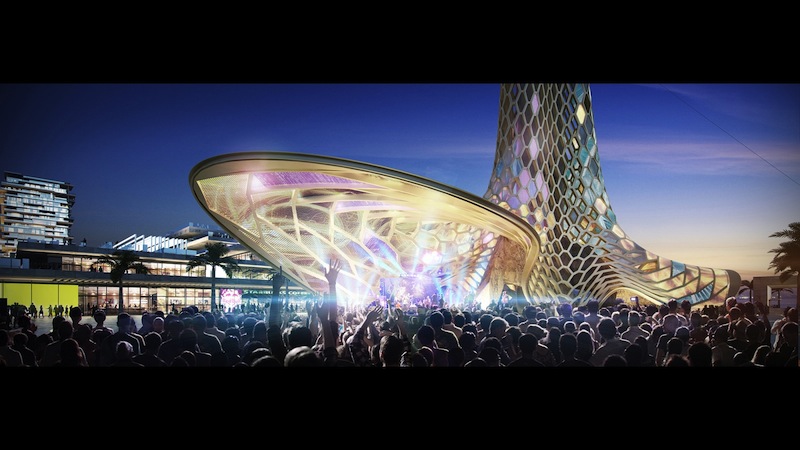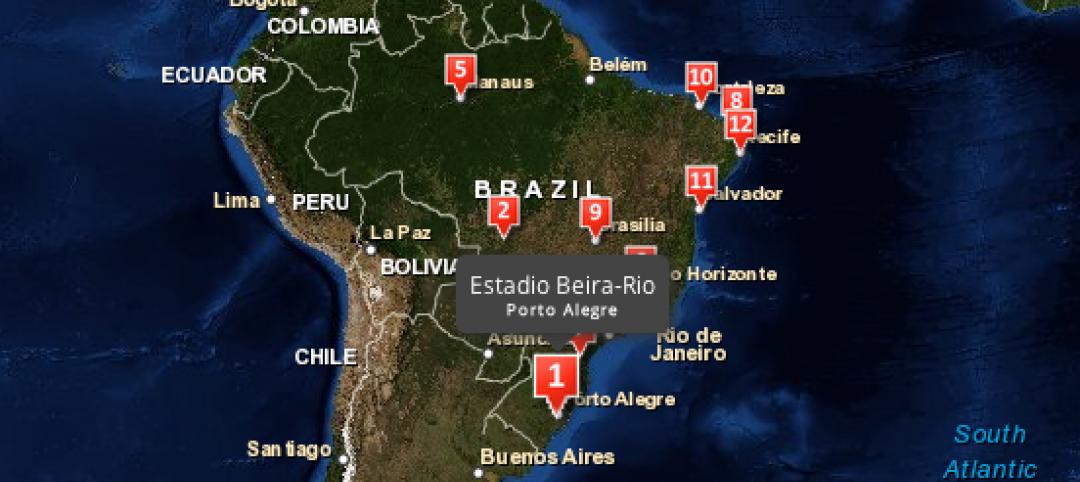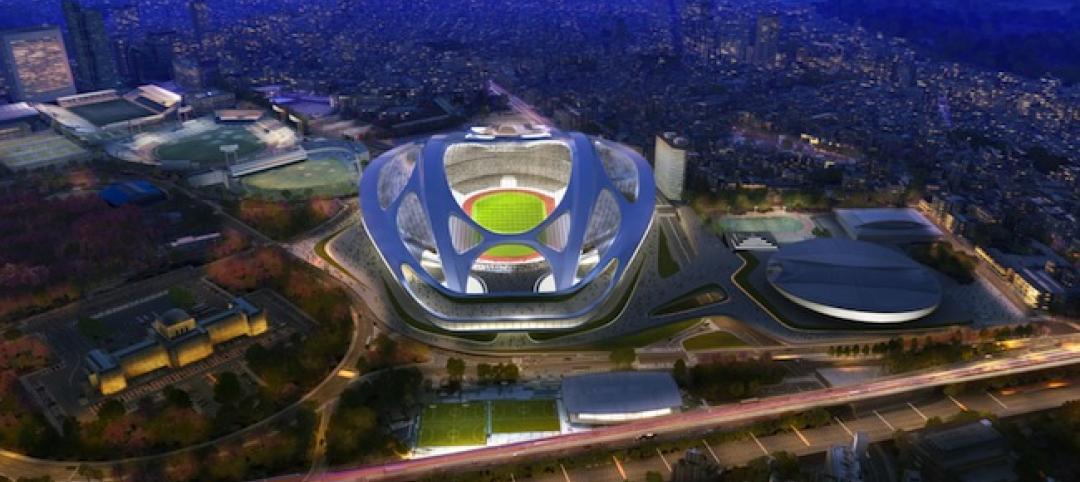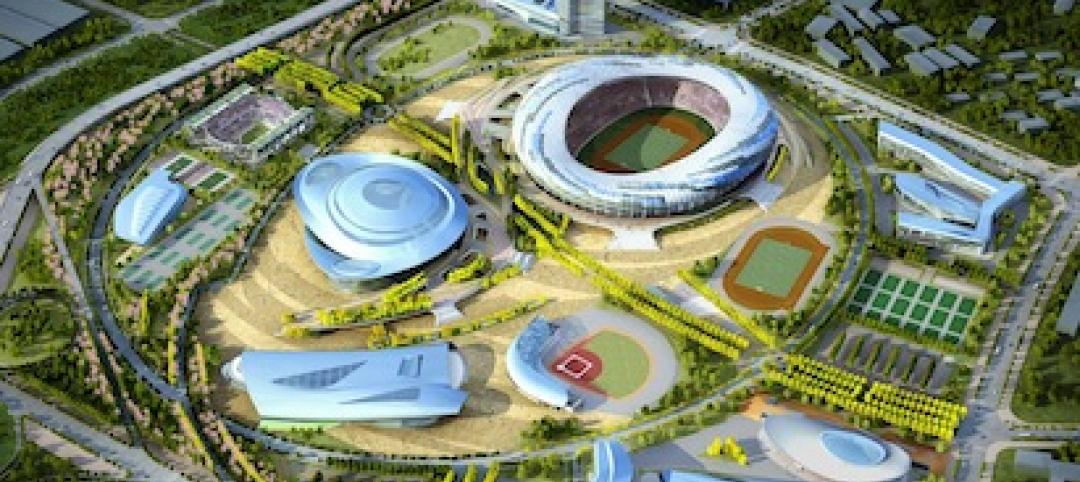Can the experience of scaling Mount Everest be duplicated in an arid, desert market whose average annual high temperature exceeds 92 F?
Dubai is that market, and the improbable has been proposed, in the form of a 300-plus-meter-tall (984.3-foot) extreme sports tower, for which the firm 10 Design has been commissioned as the design architect. If approved, the tower would be located at Dubai’s Marina, and provide opportunities for climbing, rappelling, and BASE jumping.
News of the proposal was first reported by The Council of Tall Buildings and Urban Habitat.
10 Design’s website says the waterfront site for the tower would be 106,169 sm. The tower itself would be created through an exterior hexagrid skin.
“The form morphs between two inverse triangles from the top to bottom, creating three platforms for jumping at the upper level and three open spaces at the ground for landing,” 10 Design stated. “The form is sculpted to create jumping platforms at 300 meters, 250 meters, and 200 meters. The ground floor is pushed out to create a large canopy.”
The proposed tower would attempt to reproduce the Mt. Everest experience with a series of base camps, locating a variety of extreme climbing, abseiling, and jumping activities, according to The Dubai Chronicle and other news outlets. The base and lower levels of the tower would offer training and simulation services as well as climbing walls and bungee jump towers for beginner visitors to help them up their abilities, according to the website GrindTV.com.
If this tower proposal goes forward, it might even feature ice-pick climbing, which would be a neat trick, given that Dubai’s average high temperature ranges from 75 F in January to 106 F in August.
Cost estimates and a completion date for this project were not available.
 The unusually shaped tower would allow BASE jumps from 300, 250, and 200 meters above the ground. Image: 10 Design
The unusually shaped tower would allow BASE jumps from 300, 250, and 200 meters above the ground. Image: 10 Design
 The base and lower levels of the tower would offer instruction, simulation services, and climbing walls and bungee jump towers for beginners. Image: 10 Design
The base and lower levels of the tower would offer instruction, simulation services, and climbing walls and bungee jump towers for beginners. Image: 10 Design
Related Stories
| Jun 12, 2014
Austrian university develops 'inflatable' concrete dome method
Constructing a concrete dome is a costly process, but this may change soon. A team from the Vienna University of Technology has developed a method that allows concrete domes to form with the use of air and steel cables instead of expensive, timber supporting structures.
| Jun 11, 2014
Esri’s interactive guide to 2014 World Cup Stadiums
California-based Esri, a supplier of GIS software, created a nifty interactive map that gives viewers a satellite perspective of Brazil’s many new stadiums.
| Jun 4, 2014
Construction team named for Atlanta Braves ballpark
A joint venture between Barton Malow, Brasfield & Gorrie, Mortenson Construction, and New South Construction will build the Atlanta Braves ballpark, which is scheduled to open in early 2017. Check out the latest renderings of the plan.
| Jun 2, 2014
Parking structures group launches LEED-type program for parking garages
The Green Parking Council, an affiliate of the International Parking Institute, has launched the Green Garage Certification program, the parking industry equivalent of LEED certification.
| May 29, 2014
7 cost-effective ways to make U.S. infrastructure more resilient
Moving critical elements to higher ground and designing for longer lifespans are just some of the ways cities and governments can make infrastructure more resilient to natural disasters and climate change, writes Richard Cavallaro, President of Skanska USA Civil.
| May 22, 2014
Just two years after opening, $60 million high school stadium will close for repairs
The 18,000-seat Eagle Stadium in Allen, Texas, opened in 2012 to much fanfare. But cracks recently began to appear throughout the structure, causing to the school district to close the facility.
| May 20, 2014
Kinetic Architecture: New book explores innovations in active façades
The book, co-authored by Arup's Russell Fortmeyer, illustrates the various ways architects, consultants, and engineers approach energy and comfort by manipulating air, water, and light through the layers of passive and active building envelope systems.
| May 19, 2014
What can architects learn from nature’s 3.8 billion years of experience?
In a new report, HOK and Biomimicry 3.8 partnered to study how lessons from the temperate broadleaf forest biome, which houses many of the world’s largest population centers, can inform the design of the built environment.
| May 16, 2014
Toyo Ito leads petition to scrap Zaha Hadid's 2020 Olympic Stadium project
Ito and other Japanese architects cite excessive costs, massive size, and the project's potentially negative impact on surrounding public spaces as reasons for nixing Hadid's plan.
| May 13, 2014
First look: Nadel's $1.5 billion Dalian, China, Sports Center
In addition to five major sports venues, the Dalian Sports Center includes a 30-story, 440-room, 5-star Kempinski full-service hotel and conference center and a 40,500-square-meter athletes’ training facility and office building.

















